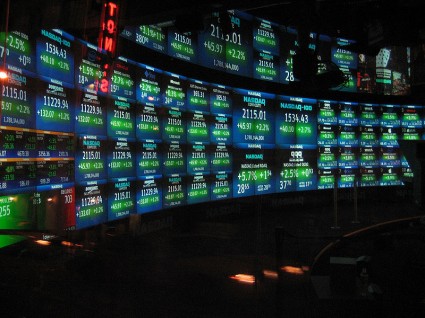 That didn’t take long. On Monday, the Dow was down another 326 points. Overall, the Dow has now fallen more than 1000 points from the peak of the market (16,588.25) back in late December. This is the first time that we have seen the Dow drop below its 200-day moving average in more than a year, and there are many that believe that this is just the beginning of a major stock market decline. Meanwhile, things are even worse in other parts of the world. For example, the Nikkei is now down about 1700 points from its 2013 high. This is causing havoc all over Asia, and the sharp movement that we have been seeing in the USD/JPY is creating a tremendous amount of anxiety among Forex traders. For those that are not interested in the technical details, what all of this means is that global financial markets are starting to become extremely unstable.
That didn’t take long. On Monday, the Dow was down another 326 points. Overall, the Dow has now fallen more than 1000 points from the peak of the market (16,588.25) back in late December. This is the first time that we have seen the Dow drop below its 200-day moving average in more than a year, and there are many that believe that this is just the beginning of a major stock market decline. Meanwhile, things are even worse in other parts of the world. For example, the Nikkei is now down about 1700 points from its 2013 high. This is causing havoc all over Asia, and the sharp movement that we have been seeing in the USD/JPY is creating a tremendous amount of anxiety among Forex traders. For those that are not interested in the technical details, what all of this means is that global financial markets are starting to become extremely unstable.
Unfortunately, there does not appear to be much hope on the horizon for investors. In fact, troubling news just continues to pour in from all over the planet. Just consider the following…
-Major currencies all over South America continue to collapse.
-Massive central bank intervention has done little to slow down the currency collapse in Turkey.
-Investors pulled more than 6 billion dollars out of emerging market equity funds last week alone.
-The CBOE Volatility Index (VIX) has risen above 20 for the first time in four months.
-Last month, new manufacturing orders in the United States declined at the fastest pace that we have seen since December 1980.
-Real disposable income in the United States has just experienced the largest year over year drop that we have seen since 1974.
-In January, vehicle sales for Ford were down 7.5 percent and vehicle sales for GM were down 12 percent. Both companies are blaming bad weather.
-A major newspaper in the UK is warning that “growing problems in the Chinese banking system could spill over into a wider financial crisis“.
-U.S. Treasury Secretary Jack Lew is warning that the federal government could hit the debt ceiling by the end of this month if Congress does not act.
-It is being reported that Dell Computer plans to lay off more than 15,000 workers.
-The IMF recently said that the the probability that the global economy will fall into a deflation trap “may now be as high as 20%“.
-The Baltic Dry Index is now down 50 percent from its December highs.
If our economic troubles continue to mount, could we be facing a global “financial avalanche” fairly quickly?
That is what some very prominent analysts believe.
Below, I have posted quotes from five men that are greatly respected in the financial world. What they have to say is quite chilling…
#1 Doug Casey: “Now is a very good time to start thinking financially because I’m afraid that this year, in 2014, we’re going to go back into the financial hurricane. We’ve been in the eye of the storm since 2009, but now we’re going to go back into the trailing edge of the storm, and it’s going to be much longer lasting and much worse and much different than what we had in 2008 and 2009.”
#2 Bill Fleckenstein: “The [price-to-earnings ratio] is 16, 17 times earnings,” Fleckenstein said on Tuesday’s episode of “Futures Now.” “Why would you pay 16 times for an S&P company? I don’t care about where rates are, because rates are artificially suppressed. Why isn’t that worth 11 or 12 times? Just by that analysis, you’d be down by a quarter or 30 percent. So there’s a huge amount of downside.”
#3 Egon von Greyerz of Matterhorn Asset Management: “Nothing goes (down) in a straight line, but the emerging market problems will accelerate and it will spread to the very overbought and the very overvalued stock markets and economies in the West.
So stock markets are now starting a secular bear trend which will last for many years, and we could see falls of massive proportions. At the end of this, the wealth that has been created in the last few decades will be destroyed.”
#4 Peter Schiff: “The crisis is imminent,” Schiff said. “I don’t think Obama is going to finish his second term without the bottom dropping out. And stock market investors are oblivious to the problems.”
“We’re broke, Schiff added. “We owe trillions. Look at our budget deficit; look at the debt to GDP ratio, the unfunded liabilities. If we were in the Eurozone, they would kick us out.”
#5 Gerald Celente: “This selloff in the emerging markets, with their currencies going down and their interest rates going up, it’s going to be disastrous and there are going to be riots everywhere…
…So as the decline in their economies accelerates, you are going to see the civil unrest intensify.”
—–
Those that do not believe that we could ever see “civil unrest” on the streets of America should take note of what just happened in Seattle.
After the Seahawks won the Super Bowl, fans celebrated by “lighting fires, damaging historic buildings and ripping down street signs“.
If that is how average Americans will behave when something good happens, how will they act when the economy totally collapses and nobody can find work for an extended period of time?
We are rapidly approaching another great financial crisis. Unfortunately, we didn’t learn any of the lessons that we should have learned last time. It is being projected that the debt of the federal government will more than double during the Obama years, the “too big to fail banks” have collectively gotten 37 percent larger over the past five years, and the big banks have become more financially reckless than ever before.
When the next great financial crisis arrives (and without a doubt it is inevitable), millions more Americans will lose their jobs and millions more Americans will lose their homes.
Now is not the time to be buying lots of expensive new toys, going on expensive vacations or piling up lots of debt.
Now is the time to build up an emergency fund and to do whatever you can to get prepared for the great storm that is coming.
As you can see from the financial headlines, time is rapidly running out.

